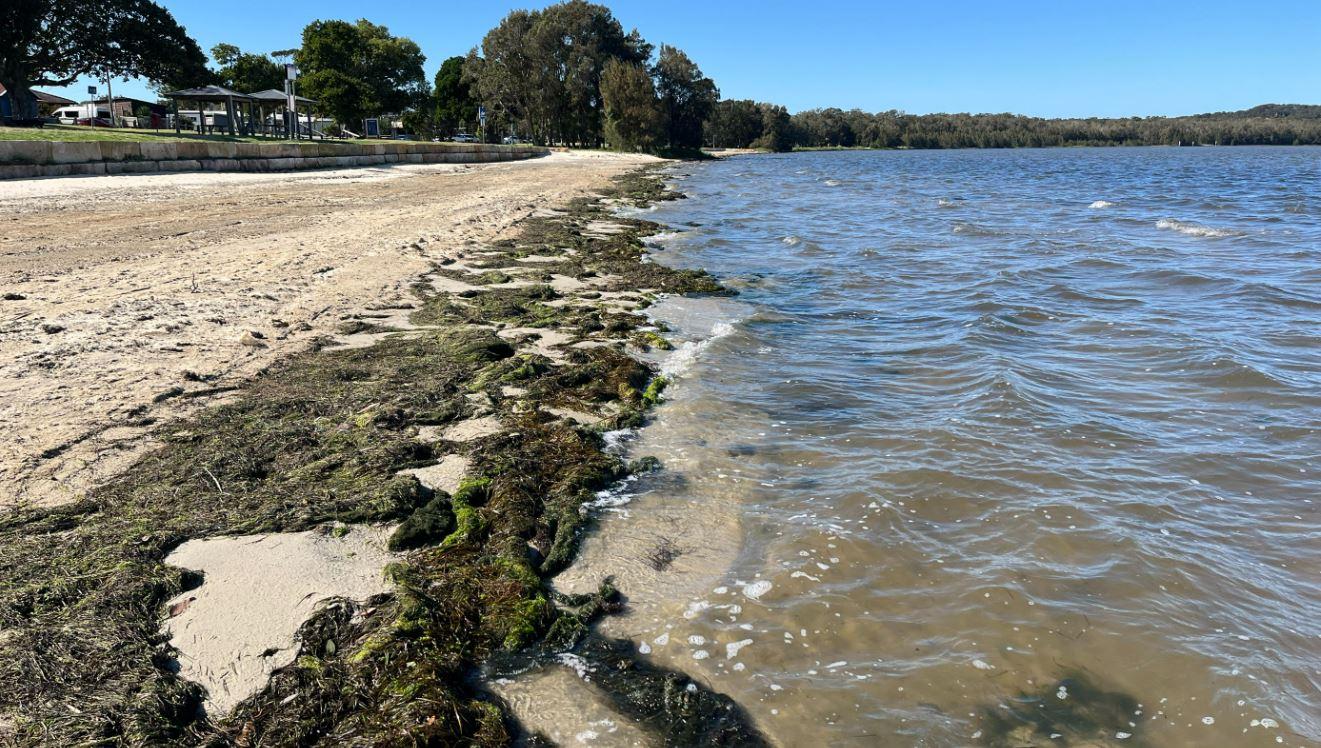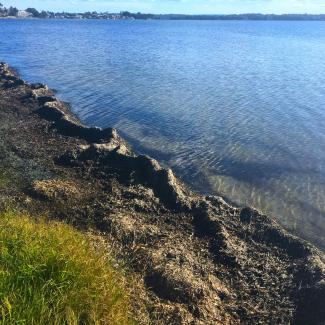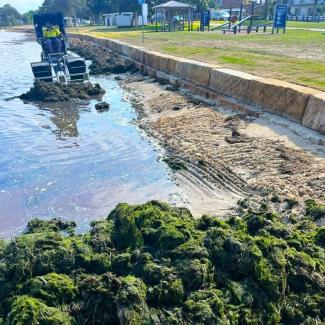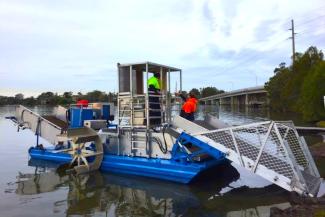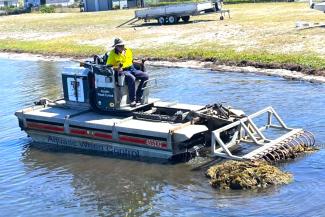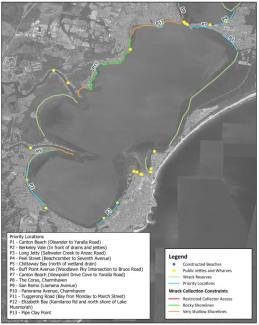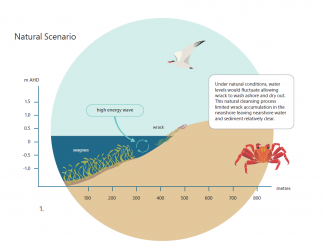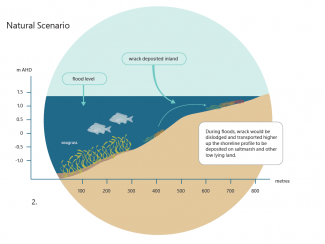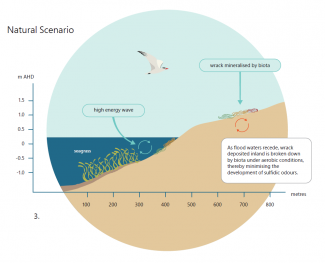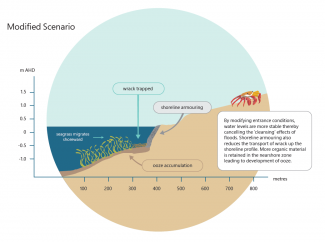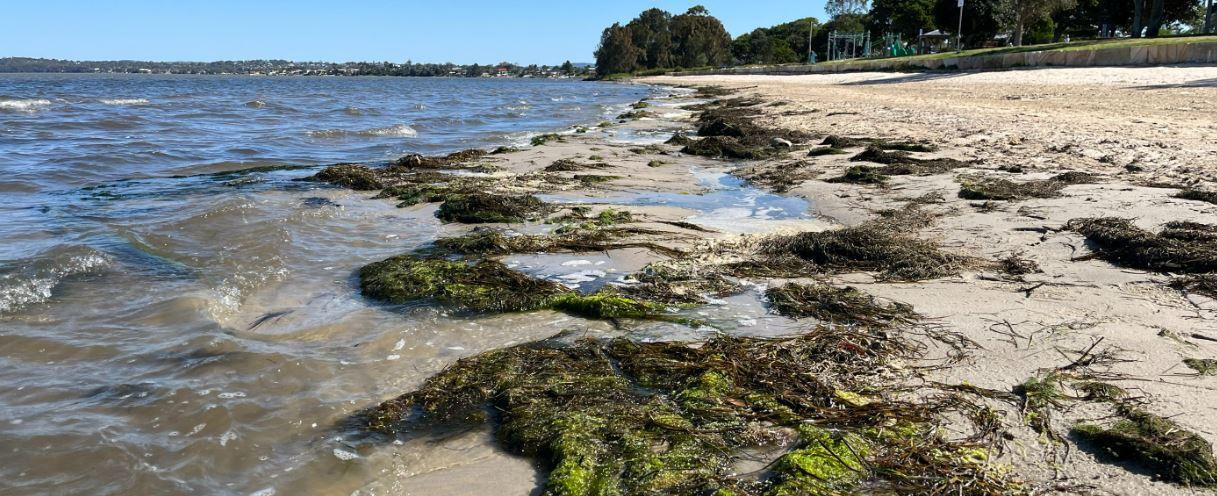
What is wrack
The detached leaves from seagrass found floating in our estuaries and washed up on our foreshores and beaches, along with other vegetative material like nuisance macroalgae, is collectively known as wrack.
Wrack plays an important role in maintaining healthy estuaries. Shedding leaves is a natural part of the seagrass lifecycle and these are spread across estuary systems by the wind and waves. Detached seagrass leaves float for around two weeks before sinking. The benefits of wrack include its ability to cycle nutrients, provide food and shelter for aquatic organisms, reduce erosion, provide protection and a nursery for small fish, and habitat for shorebirds and terrestrial species.
However, as development encroaches on our shorelines, the natural ‘self cleaning’ process of wrack depositing on foreshores through wind and waves to dry and decompose aerobically has been impacted. This results in wrack being trapped in the water and breaking down anaerobically (without air), which can lead up unpleasant smells and compromise aquatic biodiversity. (See Wrack and the Tuggerah Lakes ecology FAQ for more details)
How does Council manage wrack
Due to the lack of mixing of Tuggerah Lakes, wrack management is a high priority for Central Coast Council and the community. Proactive measures undertaken by Council include skimming floating wrack and macroalgae from the water using specialised machinery. This wrack is moved to the foreshore or ‘wrack pads’ to dry, assessed for its use as mulch on remediation sites or taken to a waste management facility.
It is important to note that Council does not harvest or cut live seagrass, and wrack collection and water access is only carried out in publicly accessible areas.
A 10 year Tuggerah Lakes Wrack Management Strategy has been developed in collaboration with the community to ensure there is strategic direction and sound scientific evidence to guide the day-to-day management of wrack in Tuggerah Lakes. (See Central Coast Council wrack management strategies FAQ for more details).
Why don’t we service other waterways
While nearby waterways also contain wrack and algae, they are deeper and more influenced by tides. This allows wrack to be naturally transported, drying and breaking down on shorelines, closer to the way nature intended.
Tuggerah Lakes, however, faces unique challenges due to its shallow depth (average 1.9 metres) and minimal tidal flushing (1%-3%). These conditions exacerbate water quality issues by trapping sediment, nutrients, pollutants, and organic matter from developed areas, introduced via stormwater and groundwater. As a result, Tuggerah Lakes require focused management to address these specific environmental concerns.
How can the community support wrack management?
Wrack collection is regulated by the NSW Department of Primary Industries. While Council is issued a permit to collect wrack under strict conditions, members of the community can collect wrack without a permit - as long as the amount collected doesn’t exceed 20kg per person, per day for personal use.
Wrack mulch can be used in gardens as a soil conditioner, placed in council green bins for regular curbside collection or placed in bags and boxes to be collected as part of a bulk green waste pick up.
While wrack has many natural benefits we also understand wrack can smell unpleasant and a deterrent for foreshore and beach goers when it breaks down anaerobically in the water, or collects in large volumes onshore. Wrack is an important part of our estuary ecosystem, and there are options to support wrack management if people have concerns.
Other community initiatives such as a community volunteer wrack collection is also being explored as part of the Tuggerah Lakes Wrack Management Strategy. (See Wrack and the local community FAQ for more details).
Wrack and the Tuggerah Lakes ecology
What is wrack?
It looks like big clumps of seaweed, but wrack is the collective name for detached seagrass and nuisance macroalgae that commonly grows in estuaries. There are three seagrass species that grow in the Tuggerah Lakes, the most dominant being Zostera muelleri subsp. Capricorni.
Why is wrack important to the ecology of Tuggerah Lakes?
Wrack is a natural part of the Tuggerah Lakes ecology. The organic matter plays an important role in the health of our estuaries by cycling nutrients, providing food and shelter for aquatic organisms, reducing shoreline erosion, providing protection for small fish and habitat for shorebirds and terrestrial species.
Leaves detaching is a natural part of the seagrass life cycle (in the same way leaves fall off any plant). Seagrass is an important indicator of estuary health and water quality, as is the presence of wrack.
What is nature’s process for managing wrack?
In a natural setting, detached seagrass floats for about two weeks before it sinks. Prior to entrance management and development in the catchment Tuggerah Lakes water levels would naturally fluctuate between 0.2 - 2.0m, and with gradual sloping unmodified shorelines this would allow the system to ‘self clean’ any sediment, vegetation or debris that gets washed onto shorelines and deposited when waters recede.
This is known as aerobic decomposition and is the preferred method for wrack management. Aerobic decomposition allows the wrack to dry out in the air and sun after being deposited onshore, it also has the added benefits of less nuisance smells and mulch value add. The wrack acts as a natural soil conditioner that allows vegetation like saltmarsh to thrive, which maintains the gradual sloping foreshore needed for the wrack to be washed ashore, as nature intended.
Yuck! What’s that smell?
We know wrack can be unpleasant and a deterrent for foreshore and beach goers as people don’t like walking across wrack, or swimming in it.
Many of our foreshore areas have been modified due to development which causes wrack to get stuck in the water instead of washed onto land to dry. When wrack builds up in the water it can’t break down with air, this causes the vegetative matter to smell. The wrack that makes it to land decomposes aerobically and generates less odour as the material breaks down much quicker.
Pollution, contamination and excess nutrients that run into the estuary via the stormwater system also add to lingering smells around our waterways. Pollution often gets trapped in wrack, and wrack is unfortunately seen as the culprit.
While it may be unpleasant, in or out of the water, wrack decomposition is a natural process.
How has human development impacted the natural process of Tuggerah Lakes?
Over the years foreshore development, including clearing and mowing native foreshore vegetation, retaining walls, jetties and wharves, land reclamation and dredging, has disrupted the natural process for wrack management. This has reduced the estuary’s ability to ‘self clean’ or deposit wrack on foreshores to break down aerobically.
Clearing of native vegetation makes the foreshore more prone to erosion and over time, wrack can get trapped in pockets at the water’s edge, unable to decompose. Land reclamation has altered Tuggerah Lakes’s natural boundaries, limiting areas where wrack can be deposited, while dredging has resulted in more static water levels impacting wrack movement.
What are Council doing?
Does Council have a strategy for long term wrack management?
A 10 year Tuggerah Lakes Wrack Management Strategy has been developed in collaboration with the community to strategically manage long term wrack collection.
The strategy considers ecological health, recreational and economic value, key collection locations and service schedule. Benefits to the community include clear communication of wrack operations, measurable KPIs to evaluate success, an adaptable strategy that allows for financial and environmental variabilities and potential solutions to historically challenging collection locations.
Strategy implementation will see increased community engagement through the establishment of a community working group, and tailored communications to improve education and awareness about wrack issues and management.
Does Council have priority wrack collection locations?
Thirteen priority wrack collection locations have been selected across Tuggerah Lake, Budgewoi Lake and Lake Munmorah. These locations were chosen by the community and collection operations scheduled in response to seasonal weather patterns, high recreation use periods and timing around reducing ecological impacts. This ensures a more strategic method of collection and transparent communication of these activities to the community.
Location of wrack collection and the service schedule are updated in response to community needs and efforts to improve the estuary’s ecological health. The 13 wrack collection locations are outlined in the Tuggerah Lakes Wrack Management Strategy.
Is there a Council wrack collection schedule?
The Tuggerah Lakes Wrack Management Strategy includes a wrack collection schedule that takes into consideration the different types of collection techniques needed for priority locations and changes in seasonal conditions throughout the year. For instance, some collections may start earlier, and finish later than the schedule if shedding evidence is apparent. Variable factors such as weather, wind, waves, wrack build up intensity, flowering times and location specific requests are also taken into account. Deployment of Council drones and remote monitoring techniques to surveil shedding are being investigated and will assist with adapting the annual schedule to changing conditions.
How does Council manage service collection areas?
As part of the Tuggerah Lakes Wrack Management Strategy, actions are being taken to increase data collection, via GPS tracking, aquatic species surveys and water quality testing, to ensure wrack operations are effective and positively impact estuary health.
The move to a seasonal wrack collection schedule means a shift away from a responsive approach, to strategic collection that will deliver measurable environmental, social and recreational outcomes.
How does wrack collection work?
Council wrack collection permits are approved and issued by NSW Department of Primary Industries, Fisheries, and the work is undertaken by a licenced contractor. Wrack collection can occur within the permit area, wrack volumes and by-catch are recorded and the material disposed of at a Council waste management facility or used on estuary foreshores in remediation projects.
Deep water wrack collection is a priority to reduce wrack accumulation in nearshore and onshore areas where ecosystem impact is greatest. However, there are some restrictions to wrack collection:
- Permit conditions do not allow for the disturbance of organic rich sediment, harm to live seagrass, saltmarsh or mobilising other bed materials such as Monosulfidic Black Ooze (MBO).
- Machinery cannot access wrack if the water is too shallow, shorelines are rocky, or where Endangered Ecological Communities such as Coastal Saltmarsh or Swamp Oak Floodplain Forest or tall reeds such as phragmites have built up.
What happens to wrack once it is collected?
The wrack is collected and stored on drying pads located around the estuary. Once dry (a process that is largely weather dependent), the wrack is loaded onto Council trucks and transported to Buttonderry Waste Management Facility to be processed into mulch or garden products, or as landfill if contaminated with sediments or other materials.
How is wrack used in saltmarsh areas?
Wrack is used as mulch in saltmarsh areas, contributing essential nutrients to the rehabilitation of the foreshores and supporting growth that will allow the wrack to wash ashore and ‘self clean’ as nature intended. Wrack as mulch has many benefits, particularly as a cost effective nutrient input and soil conditioner, and can promote grass growth through natural recruitment of native seed contained within the wrack.
What happens to the remaining wrack?
The current collection process involves dried wrack being transported to a waste management facility where it is combined into mulch and sold to the community. Wrack left on shorelines in Reserve and National Park areas provides habitat and a food source for insects, birds, and other wildlife. Alternative uses for wrack as a commercial product have been flagged by Council, such as biochar and compost.
Beach Wrack
How does Council manage beach wrack and clean up?
Council and contractors undertake wrack clean up on our beaches throughout the year. Council beach cleaning is conducted in accordance with the NSW Department of Primary Industries, Fisheries permit and usually involves a tractor or beach cleaner.
Care is taken to ensure environmental impacts of beach cleaning are minimised. Cleaning is scheduled after 7am to minimise noise, vegetated areas are avoided and beach conditions are taken into consideration before commencing works.
What beaches does Council focus on for wrack clean up?
Council has targeted beaches for wrack collection, typically high profile / high use beaches, such as those associated with surf clubs, constructed beaches or densely populated areas. Other beaches and foreshore reserves may be maintained on a case-by-case basis.
What happens to collected beach wrack?
Where possible, uncontaminated wrack is buried or spread close to the cleaned area to help stabilise beach sediments. Contaminated wrack (mixed with litter, other sediment or material) is taken to a waste management facility for processing as landfill.
What can the community do?
Can I collect wrack?
Yes! Wrack collection on public foreshores and beaches is permitted by community members, as long as the amount collected does not exceed 20kg per person, per day for personal use or disposal.
How can I use wrack?
Some people use wrack as garden mulch - in fact, it’s encouraged. Wrack is a great soil conditioner, it can be spread on the garden or mowed into the lawn. It’s also a free natural resource that anyone can use, as long as you adhere to the 20kg per person per day limit.
How can I dispose of wrack?
Wrack can be disposed of in domestic green bins for curbside collection or placed in bags or boxes for a free bulk vegetation collection. Residents are eligible for six bulk collections each year which can be booked online via 1Coast or by contacting 1300 1COAST (1300 126 278).
You can also take wrack collection to a Central Coast Waste Facility at Woy Woy or Buttonderry (fees may apply). Remember the 20kg per person per day limit applies to wrack being collected from the water and/or from public land.
Are there any Council initiatives for community collection of wrack?
Council is calling for expressions of interest to establish a community volunteer wrack collection program. Contact waterways@centralcoast.nsw.gov.au
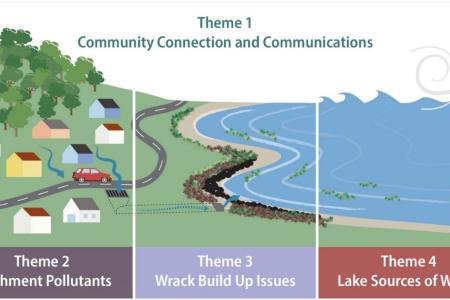
Themes for actions regarding Wrack Management in the Tuggerah Lakes Estuary
Natural events and wrack management concerns
What happens to wrack in low water and flood conditions?
Wrack management can be impacted in times of unusually low and high water levels.
Low water levels mean live seagrass beds can become exposed which can affect wrack collection, as specialised machinery used to skim wrack cannot access the shallow areas. During this time, the exposed seagrass can also be confused as large build ups of wrack, this becomes challenging as live seagrass cannot be damaged.
From an ecological point of view, low water levels can impact the shallow nearshore zones as they become decoupled from the deeper basin zones, reducing the lagoon’s ability to mix nutrients, contaminants and sediment that drains from the stormwater system. Algae blooms are another side effect of warmer shallow water and excess nutrients, which exacerbates poor water quality near the shore.
High water levels on the other hand can benefit the health of the estuary and lead to better water quality. Higher water levels can positively impact the wrack ‘self clean’ process, as sediments, organic matter and debris are washed up onto the foreshores and left to dry and breakdown aerobically when the water recedes. This natural aerobic process is preferred to anaerobic decomposition (when wrack is trapped in the water), as it generates less odour and the material breaks down much quicker.
Who do I contact if I'm concerned about wrack build up and management?
When water recedes following high water levels, Council may clear foreshores of wrack and debris, particularly in high-use recreational areas. Community members can help the clean up process by placing wrack and vegetative debris in green bins for regular curbside collection, or in bags or boxes and order a bulk green waste collection. Council will not clear private foreshores. If people have wrack concerns - contact Customer Service Centre (custhelp.com).
Files
